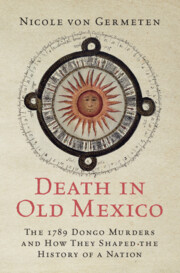Book contents
- Death in Old Mexico
- Death in Old Mexico
- Copyright page
- Contents
- Figures
- Tables
- Preface
- Acknowledgments
- Introduction
- Part I Murder
- Part II Context
- 4 The Setting
- 5 The Viceroys
- 6 The Judiciary
- Part III Justice
- Part IV Characters
- Part V Consequences
- Part VI Interpretations
- Part VII Texts
- Conclusion Death in Old Mexico
- Bibliography
- Index
5 - The Viceroys
from Part II - Context
Published online by Cambridge University Press: 02 March 2023
- Death in Old Mexico
- Death in Old Mexico
- Copyright page
- Contents
- Figures
- Tables
- Preface
- Acknowledgments
- Introduction
- Part I Murder
- Part II Context
- 4 The Setting
- 5 The Viceroys
- 6 The Judiciary
- Part III Justice
- Part IV Characters
- Part V Consequences
- Part VI Interpretations
- Part VII Texts
- Conclusion Death in Old Mexico
- Bibliography
- Index
Summary
Some of the key themes in this book – reforms of the judiciary, the planned and gruesome spectacles of late eighteenth-century justice in the viceregal capital, and the monopoly that the government asserted over violence – rest upon the decisions made by the viceroys who ruled New Spain in the 1770s and 1780s. These men combined a huge number of tasks in their daily routine including ceremonies showing respect to the king and the Catholic Church, commanding the military, collecting taxes, supervising crown monopolies, ensuring an adequate food supply, managing the budget, overseeing mining, and increasing the revenues sent back to Spain. In this era, public health and urban beautification rose to the top of their lists of responsibilities. This chapter very briefly introduces the six viceroys who either feature as main characters or who just have bit parts throughout this book.
- Type
- Chapter
- Information
- Death in Old MexicoThe 1789 Dongo Murders and How They Shaped the History of a Nation, pp. 43 - 54Publisher: Cambridge University PressPrint publication year: 2023

